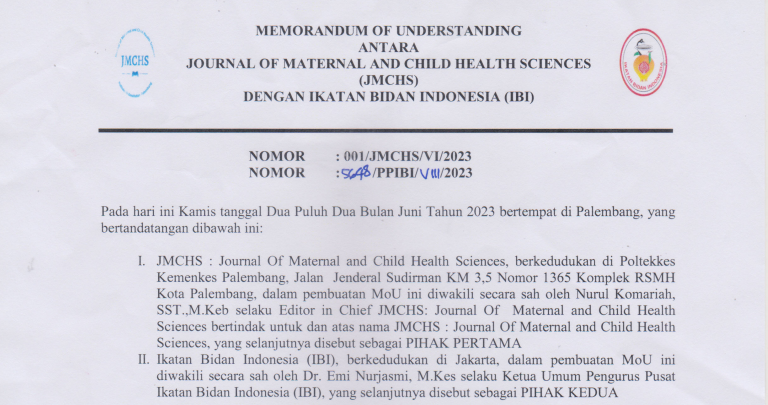Application Of Kegel Gymnastics And Audio Hypnobirthing In Midwife Care During Pregnancy To Reduce Urine Incontinence And Anxiety
Abstract
Physiological changes during pregnancy such as increased abdominal pressure and progesterone levels can make women more susceptible to urinary incontinence. As a result, more than half of women suffer from urinary incontinence during pregnancy and peaks in the third trimester. Urinary incontinence during pregnancy is a strong predictor of urinary incontinence postpartum and later in life. To prevent urinary incontinence during pregnancy, it is recommended to do pelvic floor muscle exercises (kegel exercises). In addition, the physical changes of pregnant women can also interfere with their physical and mental health so that their emotions are unstable. One of the ways that pregnant women can reduce their anxiety level is the relaxation method or self-hypnosis. Relaxation is a method that is considered quite effective for reducing muscle tension and anxiety. One of them is through audio hypnobirthing. This research was conducted to get a clearer picture of the application of the Kegel exercise method and self-hypnosis through audio hypnobirthing as an effort to reduce urinary incontinence and the resulting anxiety. This case study uses a descriptive observational method with a Continuity Of Care approach during pregnancy at Ny. N at PMB Zuniawati on 07 October 2022 to 22 October 2022. Mrs. N, who previously complained of anxiety about her pregnancy and fetus due to urinary incontinence, after being given midwifery care that was integrated with kegel exercises and self-hypnosis through audio hypnobirthing, was finally able to reduce her anxiety and expedite the delivery process
References
[2] H. Ziya and I. P. Damayanti, “Senam Kegel Sebagai Upaya Mengurangi Keluhan Sering BAK di Trimester III Kehamilan,” J. Kebidanan Terkini (Current Midwifery Journal), vol. 1, no. 2, pp. 119–125, 2021.
[3] X. Wang, Y. Jin, P. Xu, and S. Feng, “Urinary incontinence in pregnant women and its impact on health-related quality of life,” Health Qual. Life Outcomes, vol. 20, no. 1, pp. 1–8, 2022.
[4] R. M. Tähtinen et al., “Long-term risks of stress and urgency urinary incontinence after different vaginal delivery modes,” Am. J. Obstet. Gynecol., vol. 220, no. 2, pp. 181-e1, 2019.
[5] D. Altman et al., “Epidemiology of urinary incontinence (UI) and other lower urinary tract symptoms (LUTS), pelvic organ prolapse (POP) and anal incontinence (AI),” in Incontinence: 6th International Consultation on Incontinence, Tokyo, September 2016, International Continence Society, 2017, pp. 1–141.
[6] M. A. H. Hage‐Fransen et al., “Pregnancy‐and obstetric‐related risk factors for urinary incontinence, fecal incontinence, or pelvic organ prolapse later in life: A systematic review and meta‐analysis,” Acta Obstet. Gynecol. Scand., vol. 100, no. 3, pp. 373–382, 2021.
[7] E. S. Lukacz, Y. Santiago-Lastra, M. E. Albo, and L. Brubaker, “Urinary incontinence in women: a review,” Jama, vol. 318, no. 16, pp. 1592–1604, 2017.
[8] G. Kok, M. Seven, G. Guvenc, and A. Akyuz, “Urinary incontinence in pregnant women,” J. Wound, Ostomy Cont. Nurs., vol. 43, no. 5, pp. 511–516, 2016.
[9] C.-C. Liang, M.-P. Wu, S.-J. Lin, Y. Lin Jr, S.-D. Chang, and H.-H. Wang, “Clinical impact of and contributing factors to urinary incontinence in women 5 years after first delivery,” Int. Urogynecol. J., vol. 24, no. 1, pp. 99–104, 2013.
[10] S. Rafika, “Perbandingan Efektivitas Senam Kegel yang Dimulai pada Masa Kehamilan Dibandingkan Pasca Persalinan terhadap Kejadian Inkontinensia Urin Tekanan yang Menetap Pasca Persalinan= Comparison between Effectiveness Between Pelvic floor muscle training during pr,” 2019.
[11] B. Sangsawang and N. Sangsawang, “Stress urinary incontinence in pregnant women: a review of prevalence, pathophysiology, and treatment,” Int. Urogynecol. J., vol. 24, no. 6, pp. 901–912, 2013.
[12] Y.-H. Lin et al., “Persistent stress urinary incontinence during pregnancy and one year after delivery; its prevalence, risk factors and impact on quality of life in Taiwanese women: an observational cohort study,” Taiwan. J. Obstet. Gynecol., vol. 57, no. 3, pp. 340–345, 2018.
[13] E. Afrilia, S. M. Musa, and M. Lestari, “Metode Hypnosis Dalam Mengatasi Perubahan Psikologis Selama Masa Kehamilan: Studi Literatur,” J. JKFT, vol. 7, no. 1, pp. 54–58, 2022.
[14] “Laili F & Wartini E. Pengaruh Teknik Relaksasi Nafas Dalam Terhadap Kecemasan Dalam Menghadapi Persalinan Pada Ibu Hamil. JKM (Jurnal Kebidanan Malahayati). 2017; Vol 3 No 3, 152-156.”
[15] Kuswandy, Lanny. Terapi Hynobirthing: melahirkan tanpa rasa sakit persalinan, Jakarta: Pustaka Bunda. 2017. .
[16] N. Novita and K. Virgian, “Pengaruh Senam Kegel Terhadap Kejadian Inkontinensia Urin,” JPP (Jurnal Kesehat. Poltekkes Palembang), vol. 11, no. 1, pp. 3–11, 2016.
[17] S. Maharani, “Manfaat Hipnoterapi pada Ibu Hamil di Puskesmas Putri Ayu Kota Jambi,” J. Abdimas Kesehat., vol. 4, no. 1, pp. 12–16, 2022.
[18] D. Siallagan and D. Lestari, “Tingkat Kecemasan Menghadapi Persalinan Berdasarkan Status Kesehatan, Graviditas dan Usia di Wilayah Keja Puskesmas Jombang,” Indones. J. Midwifery, vol. 1, no. 2, 2018.
[19] P. Abrams et al., “Fourth International Consultation on Incontinence Recommendations of the International Scientific Committee: Evaluation and treatment of urinary incontinence, pelvic organ prolapse, and fecal incontinence,” Neurourol. Urodynamics Off. J. Int. Cont. Soc., vol. 29, no. 1, pp. 213–240, 2010.
[20] L. Anggraeni and D. R. Lubis, “Hypnobirthing Sebagai Self Hypnosis Dalam Menurunkan Tingkat Kecemasan Pada Ibu Hamil,” Pap. Knowl. . Towar. a Media Hist. Doc., vol. 7, no. 2, pp. 107–15, 2022.
[21] E. Domínguez-Solís, M. Lima-Serrano, and J. S. Lima-Rodriguez, “Non-pharmacological interventions to reduce anxiety in pregnancy, labour and postpartum: A systematic review,” Midwifery, vol. 102, p. 103126, 2021.
Copyright (c) 2023 Journal of Maternal and Child Health Sciences (JMCHS)

This work is licensed under a Creative Commons Attribution-ShareAlike 4.0 International License.
Authors who publish with this journal agree to the following terms:
- Authors retain copyright and grant the journal right of first publication with the work simultaneously licensed under a Creative Commons Attribution License that allows others to share the work with an acknowledgement of the work's authorship and initial publication in this journal.
- Authors are able to enter into separate, additional contractual arrangements for the non-exclusive distribution of the journal's published version of the work (e.g., post it to an institutional repository or publish it in a book), with an acknowledgement of its initial publication in this journal.
- Authors are permitted and encouraged to post their work online (e.g., in institutional repositories or on their website) prior to and during the submission process, as it can lead to productive exchanges, as well as earlier and greater citation of published work












